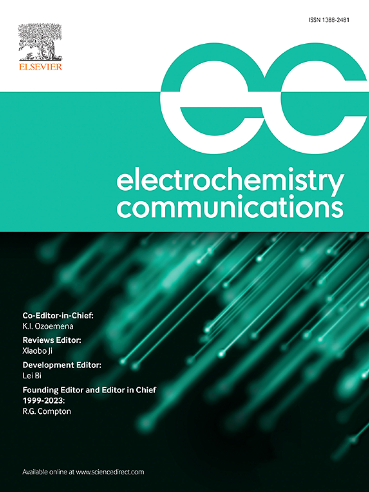离子液-电极界面:从一个适用于所有情况的定律到一个预测所有情况的模型
IF 4.2
3区 工程技术
Q2 ELECTROCHEMISTRY
引用次数: 0
摘要
双电层(EDL)——可以说是电化学的核心概念——仍然是每个人都想要破解的难题,以调整其特性,从而控制电化学设备的性能。其中一个特性是差分电容,它决定了超级电容器的能量密度。在这篇文章中,我们证明了电容-电位依赖关系可以用离子液体-电极界面的四参数模型来拟合,其中立体填充自然导致幂律缩放。首先,我们将演示如何评估这些参数并使用它们来解释EDL结构和属性。其次,我们演示了该模型如何能够预测差分电容和能量密度。本文章由计算机程序翻译,如有差异,请以英文原文为准。

Ionic liquid–electrode interface: From one law to fit them all to one model to predict them all
The electric double layer (EDL) – arguably the central concept in electrochemistry – remains the nut everyone wants to crack to tune its properties and, thus, control the performance of electrochemical devices. One such property is the differential capacitance that determines the energy density in supercapacitors. In this communication, we show that the capacitance–potential dependence can be fitted with a four-parameter model for ionic liquid–electrode interfaces, where steric packing naturally results in a power-law scaling. First, we demonstrate how these parameters can be evaluated and used to interpret the EDL structure and properties. Second, we demonstrate how the model enables predictions of both differential capacitance and energy density.
求助全文
通过发布文献求助,成功后即可免费获取论文全文。
去求助
来源期刊

Electrochemistry Communications
工程技术-电化学
CiteScore
8.50
自引率
3.70%
发文量
160
审稿时长
1.2 months
期刊介绍:
Electrochemistry Communications is an open access journal providing fast dissemination of short communications, full communications and mini reviews covering the whole field of electrochemistry which merit urgent publication. Short communications are limited to a maximum of 20,000 characters (including spaces) while full communications and mini reviews are limited to 25,000 characters (including spaces). Supplementary information is permitted for full communications and mini reviews but not for short communications. We aim to be the fastest journal in electrochemistry for these types of papers.
 求助内容:
求助内容: 应助结果提醒方式:
应助结果提醒方式:


